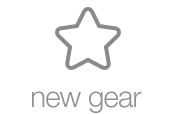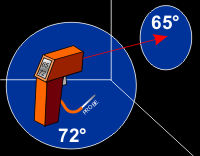Ghost Hunting Equipment 101
Since the beginning of time man has been curious about the afterlife. What happens to us after we pass? That 'haunting' question has plagued him and driven him to seek a better understanding through both spiritual/philosophic examination and scientific research.
Generally speaking, the field of paranormal investigation has been led by those who prefer to rely on spiritual and psychic means. With advancements in technology and civilizations growing more sceptical many are turning their efforts to focus more on a scientific platform. As paranormal investigators our goal is to provide undeniable proof of paranormal activity and study means in which to advance our knowledge of what lies beyond our current scope.
I will below outline the technologies that can be used for the purposes of paranormal investigation and ghost hunting. Keeping in mind that the field of paranormal research is completely theoretical at this point, we can only speculate as to what can be used and provide advice from people who have experimented which each. I have collected tips and advice from fellow paranormal investigators and noted them in this site, which I hope will provide you with a basis from which to conduct your own research into the paranormal.
Ghost Hunting vs. Paranormal Investigations
Firstly, I should probably explain the differences between Ghost Hunting and Paranormal Investigations. Although it may seem like the same thing, there is a big difference in the methodology and objectives of each.
Ghost Hunting
Generally speaking, Ghost hunting refers to the action of setting out to find proof of afterlife-based paranormal activity. This is typically done in a location previously deemed as active (or full of 'ghosts').
Paranormal Investigation
A paranormal investigation, however, is performed by a team who sets out to collect evidence to prove or disprove claims or suggestions of paranormal activity. This is typically performed as a result of a client requesting assistance in validating or debunking claims of paranormal experiences.
Before The Investigation
Fact Gathering & Research
The best tool at your disposal is 'the facts'. Our job as paranormal investigators is to gather as much information as possible. This information will be pertinent in conducting a professional, efficient and accurate investigation.
- Learn as much as you can about the location your are going to be investigating
- Research the history of the location including possible catastrophies
- Interview the client and people who are involved with the location including residents, employees, owners - whomever might have knowledge of potential activity (for the sake of the client's confidentiality, get their permission before contacting others)
- Know your team - know their strengths and weeknesses
Required Ghost Hunting Gear
For safety and proper documentation I suggest having at the very least the following items on each person for every investigation.
- Audio Recorder - An audio recorder is a must-have for any investigation - particularly on a client investigation. This is primarily to document the entire investigation as well as protecting yourself and your team in the event the client makes claims later that you said or did something you did not. Having an audio documentation of the entire proceedings should protect you in this event. See more information on types of audio recorders below. I like to call out the time to my audio recorder (called 'tagging') every 20 minutes or so. This is helpful when later reviewing the evidence.
- Flashlight - A must-have for any investigation, particularly at night and in darkened areas.
- Lots of Batteries - Because most equipment utilized during an investigation is portable and requires batteries, make sure to have a stockpile on hand of every type yoy may need.
- Notebook and Pen - This is particularly helpful when interviewing clients, jotting down areas of interest on an initial walkthrough and documenting activity as it occurs.
- A Watch - A watch is required to 'tag' your audio recorder and to note the time throughout the investigation. One with a backlight is particularly helpful.
Standard Ghost Hunting Equipment & Gear
Audio Recorders
Audio recorders are a handy tool, not only for recording EVP (electronic voice phenomena) but also for documenting your investigation. In addition, this audio documentation can prove to be helpful in the event a client claims you have said or done something you have not.
As noted, the main reason for having an audio recorder on hand during an investigation is to record potential EVPs. This phenomena occasionally is heard when an intelligent being is attempting to communicate with us. This can come through as a voice, taps, or other audible disturbances. This is particularly notable when heard as a response to a question or a request for signs of one's presence.
There are two main types of audio recorders including:
Digital Audio Recorder
Digital audio recorder, a more recent technology, uses an internal hard drive to record audio. This gives you the ability to record many hours depending on the size of the internal drive. They are typically very small and include a manner in which to plug the device into your home computer to retrieve the audio data - typically via a USB connection. This audio is typically in a standard format such as MP3, WAV, or WMV - again, depending on the type of recorder you get. Most recorders will also allow you to separate out audio into folders making it easier to note which segment is for what.
EVP Recorder Wrist Band - Easy to use EVP audio recorder you wan wear on your wrist like a watch. It's easy to use and super 'handy' (haha hand puns).
Most digital audio recorders require a separate USB cable. There are, however, models that plug right into your computer via USB without the need for a cable. I prefer this route as I am prone to losing things and I have enough random cables as it is. I don't need another one.
These units I suggest as they do not require a separate cable.
Olympus - Compact digital audio recorder has a built in USB plug (does not require a cable) and records with great quality up to 272 hours of audio.
Tape Recorder
Tape, recorders, unlike digital audio recorders utilize an analog tape to record. Some stand by this older technology claiming it records in a more natural environment. I, for one, prefer the ease of use and efficiency of the digital. In addition, because of the moving gears used in tape recorders, they tend to pick up sounds generated internally by the device. This can be detrimental to your evidence collecting.
How Do You Transfer Audio From Your Digital Recorder To Your Computer?
I get this question a lot. Now that you've gotten your digital audio recorder, how do you get the audio off the recorder on to your computer an clip out what you want. Since, all manufacturers do things slightly different you should really read the manual that came with your device for instructions on how to get the audio onto your computer. That aside, you can generally follow these basic steps:
- Plug your digital audio recorder into any available USB slot. If you're not sure what that is, basically plug it in anywhere it will fit.
- Macs and most PCs with Windows 2000, XP or Vista will automatically detect the device
- Find your device and where the audio files are located.
- MAC: Open your Finder. You should see a mounted drive in the top left corner indicating the device. Click on that and browse into the folders to find your audio files (typical formats include MP3, WAV, or WMV). Double click the file to listen.
- WINDOWS: Go to My Computer. You should see a mounted drive somewhere indicating the device. Double click on that and browse into the folders to find your audio files (typical formats include MP3, WAV, or WMV). Double click the file to listen.
How Do You Clip Out Sections Of The Audio And Edit?
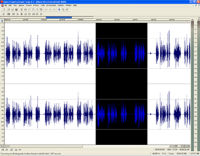 Now that you've gotten the audio file onto your computer you're ready to review the evidence. Once you've found something particularly interesting you'll most likely want to clip out that section to send to your team for review or put up on the internet, right? To do this, you need a program capable of this. There are many out there, so here are a few I suggest:
Now that you've gotten the audio file onto your computer you're ready to review the evidence. Once you've found something particularly interesting you'll most likely want to clip out that section to send to your team for review or put up on the internet, right? To do this, you need a program capable of this. There are many out there, so here are a few I suggest:
- Audacity: A great application for simple tasks like clipping and cleanup PLUS it's FREE!
- SoundForge: This is my favorite application for advanced audio tasks.
- Adobe Soundbooth: The standard Adobe suite for production editing. Works seamlessly with Adobe Premier for integration with video and Flash.
With each of these applications you can visually see the audio levels while you're listing to it. To clip out what you want, simply select the preferred area with your mouse and Copy/Paste that section to a new file. Some applicatons may also have an option to save the selected area to it's own file.
TIP: When clipping possible audio for evidence, select at least 30 seconds before and after the focal area. This helps those listening to get a better idea of what is happening during the time of the activity.
Cameras
One of the basic function tools of every investigation is a camera. They can be used not only for detecting paranormal activity but for documenting your investigation. There are a number of types of cameras out there serving different purposes.
Digital Cameras
Digital cameras are, of course, the easiest to use. Because you can transfer high quality photos directly from a digital camera right to your computer it saves time and money in having to process film. The drawback, however, is that many are not as flexible with their settings and have (in many cases) and long lag period when taking photos.
Camera Modifications (IR/Full Spectrum)
Cameras can be modified to see further into the light spectrum than we can see with our naked eye. On one end of the spectrum is Infrared (or IR) while on the opposite end is Ultraviolet (UV). Cameras can be modified through adjusting or removing filters to see deeper into either end of the spectrum. Conversion of the camera to see deeper into both IR and UV is called Full Spectrum.
There are different theories as to what constitutes good Full Spectrum. In some cases the filter is removed and in others it is replaced to see IR and UV but NOT the visible spectrum. I consider the latter (where visible light is blocked) as a multi-spectrum modification, not Full Spectrum. While this method may be practical for daylight uses where bright visible light can overlap the IR and UV this is not an issue when conducting nighttime paranormal investigations in mostly dark.
Suggested Cameras:
Full Spectrum Digital Camera - Takes quality Full Spectrum photos and video with the convenience and ease of a compact digital camera
EMF Meters (Electro Magnetic Field)
EMF meters measure fluctuations in electromagnet fields (or EM fields). These fields are a direct result of electrical appliances in home, cell phones, power lines outside and even fluctuations in solar activity and weather. Beyond that, a primary theory in the paranormal world is that entities can manipulate these fields in their attempt to manifest themselves or interact with our world. The units of measurement registered on an EMF meter is called milligauss.
There are a large number of EMF meters on the market with various features. The two main differentiation are Single Axis and TriField (or tri-axis) explained below.
Single Axis
Single axis EMF meters, like all EMF devices measure fluctuations in electromagnetic fields. These meters, however, read these fluctuations in one direction. Typically this direction is directly ahead of you (as you hold the device in front of you with the display up).
Suggested Single Axis Meters:
Rook EMF Meter - As far as single axis meters go, I prefer this one. It has an audio and visual alarm to alert you when higher readings are detected. Additionally, this meter is built to be less susceptible to interference.
Digital EMF Meter - This meter has a digital display in documenting specific readouts.
TriField Meters
TriField meters on the other hand, measure fluctuations in electromagnetic fields but in 3 axis - X, Y and Z. These devices measure in all directions.
TriField 2 Meter - This meter offers magnetic, electric, and radio/microwave detection in one package. Includes an analog readout and an adjustable audio alert. This meter, however, focuses mainly on 'AC' or man-made electrical and magnetic fields. This meter is moreso effective in detecting man-made currents to debunk claims of 'being watched' which can be caused by faulty wiring and/or electrical leakage. For detecting paranormal activity, you're better off with the TriField Natural EM Meter above.
Camcorders / Video Cameras
Another basic tool for every investigation is some kind of video capture device. Camcorders (or handheld video cameras) have become a staple mainly along with the more recent affordability of them. They can be used not only for detecting paranormal activity but for documenting your investigation. There are a number of types of camcorders, modifications and accessories to mold it to your use and investigation style.
Full Spectrum Camcorders and Cameras
 Most camcorders can be modified to see further into the light spectrum than we can see with our naked eye. On one end of the spectrum is Infrared (or IR) while on the opposite end is Ultraviolet (UV). Cameras can be modified through adjusting or removing filters to see deeper into either end of the spectrum. Conversion of the camera to see deeper into both IR and UV is called Full Spectrum.
Most camcorders can be modified to see further into the light spectrum than we can see with our naked eye. On one end of the spectrum is Infrared (or IR) while on the opposite end is Ultraviolet (UV). Cameras can be modified through adjusting or removing filters to see deeper into either end of the spectrum. Conversion of the camera to see deeper into both IR and UV is called Full Spectrum.
There are different theories as to what constitutes good Full Spectrum. In some cases the filter is removed and in others it is replaced to see IR and UV but NOT the visible spectrum. I consider the latter (where visible light is blocked) as a multi-spectrum modification, not Full Spectrum. While this method may be practical for daylight uses where bright visible light can overlap the IR and UV this is not an issue when conducting nighttime paranormal investigations in mostly dark. Since ghost hunting and paranormal investigating is typically done in the dark, you need all the light you can get.
The PHOTO to the right is a comparison of 'OUR' Full Spectrum and 'The Other Guys' that block visible light. This quick test makes it quite obvious that, in dark situations, blocking visible light can be quite detrimental to documenting anything.
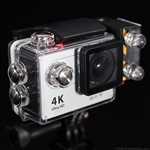 Suggested Camcorders for Ghost Hunting:
Suggested Camcorders for Ghost Hunting:
Full Spectrum Camcorder - Full Spectrum HD Camcorder and camera. This video camera offers 4K quality needed to capture clear evidence. This camcorder has been professionally developed with UV and IR sensitivity to view the full spectrum of light including light not seen with the human eye.
Dual-Use Camcorder - The benefit of this camcorder is that it can be used for ghost hunting in addition to every day use. This camera has night vision (full spectrum) and normal light modes.
Accessories
All cameras (just like our eyes) require a good light source. Many can be attached directly to your camera using a shoe mount or tripod mount. The type of light source depends on the kind of camera you are using. An Infrared (IR) sensitive camcorder should be accompanied by an IR light source which is essentially a light that gives off only Infrared light. A Full Spectrum camera should be accompanied by a special Full Spectrum light source. Some people will use a bright white light source with a Full Spectrum camera. The downside to that is lighting up the whole room while you're investigating. This can be distracting to everyone in the investigation group.
Suggested Lighting:
Full Spectrum Light - Specially made for Full Spectrum video capture this Full Spectrum light has Infrared, Red, Blue, Green, and Ultravoilet LEDs for true full spectrum illumination. No white or clear light are emitted from them helping maintain a low light room while investigating.
Infrared Camcorder Light - This light has 36 LEDs for a good IR light source. It will attach to just about any camcorder via a shoe or tripod mount.
Laser Grid
Have you ever caught movement on camera and you can't quite make out it's shape or whether it even has a mass to it? Using a laser grid helps determine both!  I have been using custom made laser grids for years to more clearly detect when movement happens and help define it's shape and whether it actually has some kind of mass to it. It's best to place a laser grid in front of a running camera throughout the investigation. Upon review if movement happens it will be obviously apparent by the breaking of the laser pattern. You can from there go frame by frame in the video marking where the pattern shifts thereby drawing an outline shape of the entity itself. If the pattern moves a certain way you can even determine if the entity has 3-dimensional mass and map that as well.
I have been using custom made laser grids for years to more clearly detect when movement happens and help define it's shape and whether it actually has some kind of mass to it. It's best to place a laser grid in front of a running camera throughout the investigation. Upon review if movement happens it will be obviously apparent by the breaking of the laser pattern. You can from there go frame by frame in the video marking where the pattern shifts thereby drawing an outline shape of the entity itself. If the pattern moves a certain way you can even determine if the entity has 3-dimensional mass and map that as well.
Suggested Lasers:
Laser Grid Scope - his high powered laser emits a grid of green dots useful for detecting shadows or general visual disturbances during an investigation. Set it in front of a running camera to catch potential evidence.
Laser Grid GS1 - Laser grid mapping system that creates an actual grid pattern for determining spacial measurements such as size, speed of movement and 3-dimensional volume (3D).
Motion Detectors
Ever received reports of footsteps or shadow people? It's relatively common. Motion sensors are a good way to detect movement.
A motion sensor detects movement within a given range ahead of it and alerts you to the occurance through an audio or visual alert.
Suggested Motion Detectors:
Geophone Motion Sensor - This ultra-sensitive Geophone circuit 'listens' to vibrations in the ground. The LEDs with light up the moment any vibration or movement is detected. The closer it gets, the higher the LED reading.
Mel Meter Vibe - Simultaneous EMF, Vibration, Touch and Temperature Readout with Red Illuminated Display and Red Flashlight
Thermometers
One theory in paranormal investigations is that entities can manipulate temperature when attempting to manifest themselves or interact with us. You may find cold or warm spots in a room where no cause in apparent. This may be indicative of something trying to make contact.
To detect these anomalies, you will need a thermometer and a little common sense. If you find a cold spot, for instance, look for any possible source of the cooler temperature. Look for open vents, windows and fans as possible sources. Move the thermometer in every direction to find where the area starts and ends. If the anomaly is relatively concentrated in on area with no attachments to possible sources, you may have something attempting to manifest. This is the time to break out your cameras and audio recorders to attempt furthering your evidence with communication and/or visuals.
The biggest mistake people make with thermometers, however, is using the wrong type. Here are the two main types of thermometers:
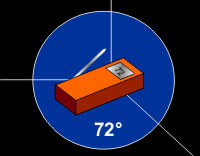 Ambient Thermometers
Ambient Thermometers
A probe thermometer includes a small metal rod or 'bullet' used to detect ambient temperature (air surrounding the device). This means you are detecting area around you looking for 'pockets' or abnormal temperature.
This ambient temperature is what you need to detect temperature changes directly around the sensor. Either set it down or move it around to find changes in temperature.
Example Probe Thermometer:
Mel Meter - Backlight probe thermometer with large display detects ambient temperature and EMF.
Infrared / Non-Contact Thermometers
Many people mistakenly use an infrared/non-contact thermometer to detect ambient temperature. These devices read infrared radiation from whatever surface it is 'looking' at. This could be from across the room. Most include a red laser light so that you can see where the device is pointing. For this purpose, lets say you're pointing it at a wall directly across the room from you. The laser, itself, has nothing to do with the actual reading. It just allows us to get a better gauge of where we're pointing it. The signature takes the temperature of the surface area and reports back to the device. What you are doing is taking the temperature of the wall across the room - NOT the temperature around you. This serves little or no purpose in detecting cold spots. However, this is effective for detecting potential sources or abnormal temperature. For instance, if you notice a temperature change in the room you are in, you'll want to find a source of that. Point the infrared thermometer at every vent and window to see if colder air is coming through.
Don't get confused! Some infrared/non-contact thermometers do not have a laser on them. So although you may think it's a probe thermometer it may not be. Make sure to read the descriptions on the device before purchasing.
Best Of Both Worlds
Your best bet for usage in paranormal investigations is to get an infrared thermometer that ALSO includes a probe (usually called a K probe). This way you can use both techniques discussed above to simultaneously to detect cold/warm spots around you and their possible sources.
Suggested Infrared/Probe Thermometers:
Trigger Themometer with Ambient Readout - Great compact infrared/probe thermometer that detects ambient temperature.
Advanced Ghost Hunting Equipment
BooBuddy Ghost Hunting Bear
The all-in-one TALKING ghost hunting companion with many tools.
BooBuddy is like having an entire kit of ghost hunting gear put together in a trigger object - a cute one. BooBuddy detections EMF, temperature and movement changes then response. Yes, it talks. BooBuddy will respond in a child-like voice to indicate change in the environment such as, "Brr, it's cold in here." and "That tickles." It will also ask EVP questions to promote a response.
- It talks!
- Detects EMF, temperature and motion
- Asks EVP questions
BooBuddy Ghost Hunting Gear - The all-in-one ghost hunting trigger object.
DVR Surrveilence Systems (Digital Video Recorder)
More info coming soon on...
PC-Based Systems
Stanalond DVR Systems
USB PC-Based Systems
Thermal Imaging Cameras
More info coming soon on...
Experimental
Ovilus
RT-EVP
Puck/The 'Box'
Safety & Communication Equipment
- First Aid Kit - It's a good idea to have a first aid kit on-hand in the even anyone is hurt
- Cell Phone - For communication outside the investigation in the event you need directions to a location or need to call 911
- 2-Way Radios - Great for quick communication amongst the team when seperated on an investigation
STEPS TO INVESTIGATION
More info coming soon on...
More about ghost hunting equipment



